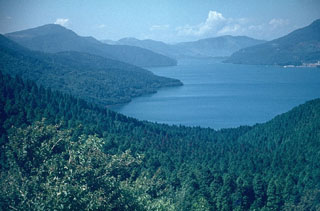Report on Hakoneyama (Japan) — April 1991
Bulletin of the Global Volcanism Network, vol. 16, no. 4 (April 1991)
Managing Editor: Lindsay McClelland.
Hakoneyama (Japan) Brief earthquake swarm in center of caldera
Please cite this report as:
Global Volcanism Program, 1991. Report on Hakoneyama (Japan) (McClelland, L., ed.). Bulletin of the Global Volcanism Network, 16:4. Smithsonian Institution. https://doi.org/10.5479/si.GVP.BGVN199104-283020
Hakoneyama
Japan
35.233°N, 139.021°E; summit elev. 1438 m
All times are local (unless otherwise noted)
A swarm of ~300 earthquakes (M <= 2.5) was recorded between 1000 and 1300 on 22 April. Several of the earthquakes, located at 5 km depth in the central part of the caldera, were felt by area residents. Seismicity gradually declined, and had returned to normal by 24 April. No changes in surface activity were observed. Earthquake swarms have been recorded about once a year, including one in August 1990 (M <= 5.1), at the volcano's E foot. Hakone erupted phreatically about 3,000 years ago, and many fumaroles and hot springs remain active.
Geological Summary. Hakoneyama volcano is truncated by two overlapping calderas, the largest of which is 10 x 11 km wide. The calderas were formed as a result of two major explosive eruptions about 180,000 and 49,000-60,000 years ago. Scenic Lake Ashi lies between the SW caldera wall and a half dozen post-caldera lava domes that were constructed along a NW-SE trend cutting through the center of the calderas. Dome growth occurred progressively to the NW, and the largest and youngest of these, Kamiyama, forms the high point. The calderas are breached to the east by the Hayakawa canyon. A phreatic explosion about 3000 years ago was followed by collapse of the NW side of Kamiyama, damming the Hayakawa valley and creating Lake Ashi. The latest magmatic eruptive activity about 2900 years ago produced a pyroclastic flow and a lava dome in the explosion crater, although phreatic eruptions took place as recently as the 12-13th centuries CE. Seismic swarms have occurred during the 20th century. Lake Ashi, along with the thermal areas in the caldera, is a popular resort destination SW of Tokyo.
Information Contacts: JMA.

